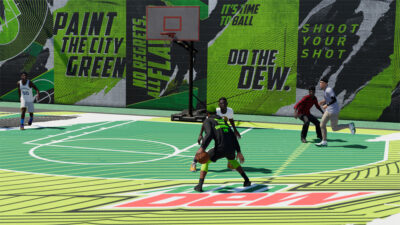The words “video game advertising” conjure images of digital billboards in virtual worlds, but that doesn’t capture the full breadth of advertising opportunities video games have to offer.
Games can support intrinsic or native in-game ads, as well as ads that are delivered alongside gameplay but exist outside the game itself, like pause-menu display ads and rewarded video.
Marketers can also sponsor and advertise on channels related to gaming, such as at esports events and across online streaming platforms, particularly Twitch and YouTube.
Because advertising and sponsorships make it possible for gamers to build a career out of their hobbies, there are also ample opportunities for influencer marketing.
And we can’t forget about the metaverse. Although the metaverse is still nascent, people have been playing immersive video games in metaverse-like environments for years.
Intrinsic in-game ads
Strictly speaking, “in-game advertising” refers to intrinsic in-game ads – that is, ads that appear in a game world during gameplay.
In addition to virtual billboards, these types of ads include branded in-game assets (see Gatorade coolers on the sidelines of basketball games) and environments (see Balenciaga’s branded experiences in Fortnite featuring unique outfits, locations and quests for players to complete).
 There are two main categories of intrinsic in-game ads: static and dynamic.
There are two main categories of intrinsic in-game ads: static and dynamic.
Static in-game ads are hardcoded into a game itself. They live permanently in the game environment and cannot be changed or updated. These types of placements require a direct relationship with game publishers who program the assets into their games, often with a high degree of developer oversight.
Dynamic in-game ads are customizable placements that can either be filled programmatically by bidding via in-game ad exchanges or via direct deals. In-game billboards and signs tend to be the most popular dynamic placements, but dynamic in-game ads can also include replacing a generic item like an unbranded soda can with one that’s identical to a real-world product.

Because gamers value immersion, dynamic in-game ads are only suited to certain types of games. They tend to be popular in sports games, racing games and open-world games that evoke real-world, ad-heavy environments, said Kelsey Chickering, a principal analyst at Forrester.
It’s worth noting that the static vs. dynamic categorization for video game ads isn’t commonly referenced by industry insiders because of the potential for confusion. “Static” and “dynamic” categories are more typically used to describe different types of display ads on the web, Chickering said.
Around and away from the game
Ads that appear outside the game world itself, but are still encountered in the course of playing a game, fall into the “around-the-game ads” bucket (for lack of a better term).
This category includes display ads that appear in a game’s start or pause menus, as well as interstitial pre-roll and mid-roll video formats.
Interstitial ads are generally unpopular with gamers because they break immersion, but gamers appreciate formats that add value to their gameplay experience, said Sarah Stringer, Dentsu’s head of US media partnerships.
Rewarded ads – particularly rewarded video – are the most popular type of around-the-game placements. Gamers view these ads in exchange for an in-game reward, such as power-ups or extra turns. Crucially, it’s the player who chooses whether to engage with the ad. The majority (76%) of US mobile gamers prefer opt-in rewarded ads to mandatory ads, according to eMarketer.
Say a gamer runs out of lives and is confronted with a “game over” screen. They may encounter a prompt to watch a video ad in exchange for extra lives, which they might otherwise have to pay real money for. This type of reward is a win for the gamer, who gets to play for longer, and a win for the publisher, who gets to keep its user base engaged for longer periods of time, which equals more impressions.
Display ads that appear on game console home screens and on PC-based game platforms like Steam are also part of the around-the-game category.
Esports sponsorships, influencer marketing and advertising on gamer-friendly streaming platforms, podcasts and social media could be considered a third flavor of “away-from-the-game” ads, said Francesco Petruzzelli, CTO of in-game ad platform Bidstack.
But influencer marketing is only an effective method for brands to enter gaming if they’re doing so in a way that respects how protective gamers can be about their spaces, Dentsu’s Stringer said. Be respectful and gamers won’t balk.
“Gamers are aware of the business around being able to make this passion something you can do full time, and they appreciate that,” she said.
Open-web programmatic
Open-web programmatic in-game ad infrastructure is still in its early days, so almost all in-game ad placements are sold via private marketplace (PMP) deals, Petruzzelli said.
Dynamic in-game ads therefore remain a small but growing slice of the video game ad market. Today, most programmatic video game placements tend to be around-the-game ads, such as rewarded videos, interstitial ads and display ads in menus.
 And for now, programmatic is almost exclusively limited to mobile and desktop games, said Pubfinity CRO Andre Sevigny.
And for now, programmatic is almost exclusively limited to mobile and desktop games, said Pubfinity CRO Andre Sevigny.
Brand presence in programmatic video game advertising is on the rise, but at least 80% of programmatic in-game ads are acquisition campaigns for other games, Sevigny said.
Game publishers want to court more business from brands because running acquisition campaigns for other games risks losing players. But many brands are still hesitant to dip their toes into the programmatic pool because of brand-safety concerns about violent video games and abuse in fan communities.
Microtransactions and more
Video game advertising is heavily associated with mobile game apps, which are largely free to play thanks to ad support. However, Microsoft and Sony recently announced plans to integrate ads into free-to-play games on Xbox and PlayStation consoles.
In addition to advertising, mobile games also make a lot of money off of in-app microtransactions and the sale of virtual goods, such as alternate outfits, playable maps or levels and superpowered in-game equipment. Microtransactions are also widely used in console and PC games.
While microtransactions aren’t usually considered part of the advertising ecosystem, they formed the foundation for the burgeoning in-game ecommerce market, and some branded in-game assets are sold this way.
Games loaded with microtransactions are known as “gacha games.” (Gacha is pronounced like “gotcha,” but that’s just a coincidence. The name is derived from “gashapon,” a Japanese term for vending machines that sell toys in plastic capsules, as well as the toys themselves.)
Finally, “advergames,” or games created explicitly to promote a brand, are also popular. These types of games have been common since the 1980s, including 1993’s Cool Spot, a (surprisingly critically acclaimed) platformer featuring the forgotten 7 Up mascot and 2006’s Sneak King, a stealth-based starring vehicle for the Burger King mascot.
Over the past decade, advergames have proliferated on mobile and desktop platforms. Take, for example, the 2011 classic Oreo Twist, Lick, Dunk game. Or McDonald’s Crush the Rush Crew, a “working at McDonald’s” simulator the fast-food giant launched in May 2022 to attract candidates for 25,000 job openings in Canada.





















